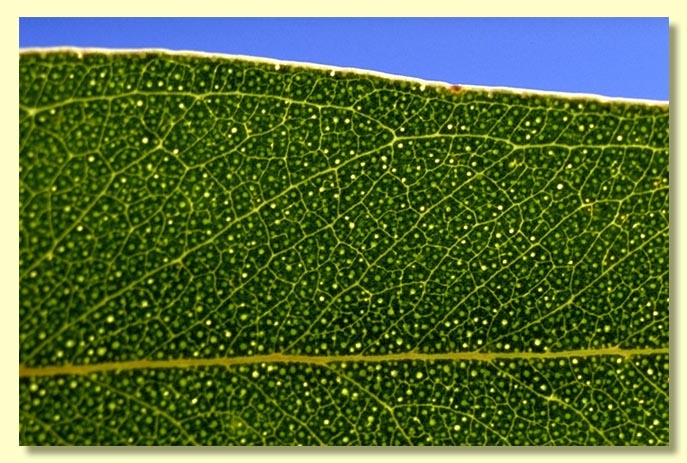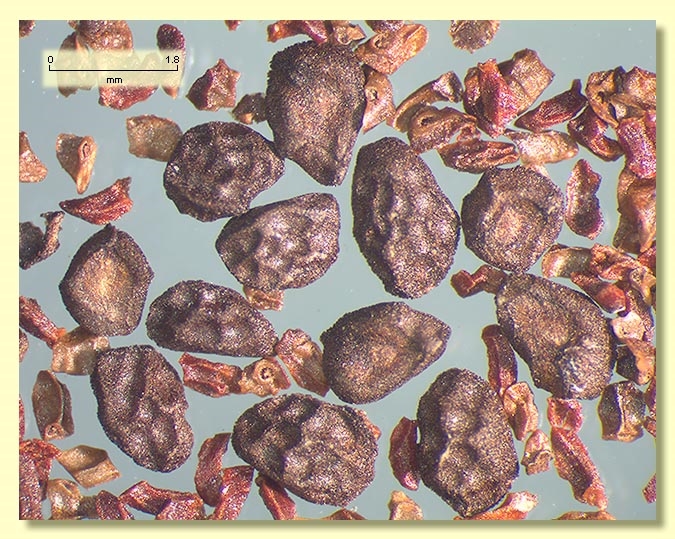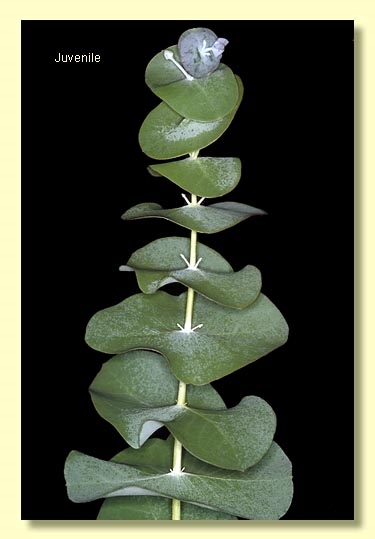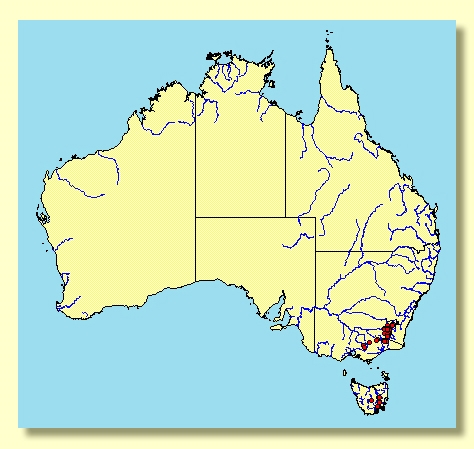Euclid - Online edition
Eucalyptus perriniana
Eucalyptus | Symphyomyrtus | Maidenaria | Euryotae | Orbiculares
T: Tasmania, north of Hamilton, L. Rodway s.n., May 1892; lectotype: HO [HO 16178]; fide Bean, A.R., Telopea 12(4): 518-519 (2010).
Bark smooth throughout, or rough only at base of trunks of largest individuals; smooth bark light coppery to greenish or white, shedding in ribbons; branchlets usually glaucous with leaf ring scars.
Juvenile growth (coppice or field seedlings to 50 cm): stem rounded in cross-section, glaucous or non-glaucous; juvenile leaves opposite, sessile, cordate (i.e. bases not joined) for first 2 nodes then with leaf bases connate for many nodes, the joined pair of leaves being elliptical to orbicular, 3.2–8.5 cm long, 5–8(10) cm wide, grey-green or slightly glaucous; dead juvenile leaves loosen from stem and spin around it.
Crown of reproductive plants retaining many juvenile leaves; petiolate, lanceolate intermediate and adult leaves not always formed. Crown leaves opposite or alternate, petiole 0–1.7 cm long; blade broadly ovate to lanceolate, 7–16.5 cm long, 1.2–5.2 cm wide, bases connate or tapering to petiole, concolorous, dull, green to grey-green or slightly glaucous.
Adult leaves, when formed, alternate, petiolate, lanceolate, green to grey-green, tapering base, acute apex, dull, side-veins greater than 45° to midrib, moderately to densely reticulate, intramarginal vein parallel to and well removed from margin, oil glands mostly island.
Inflorescence axillary unbranched, peduncles 0.2–0.5 cm long, buds 3 per umbel, sessile or on pedicels to 0.2 cm long. Mature buds ovoid, 0.6–0.7 cm long, 0.4–0.5 cm wide, green to yellow to red under wax, scar present, operculum conical to rounded or rarely beaked, stamens inflexed, anthers cuboid or cuneate, versatile, dorsifixed, dehiscing by longitudinal slits (non-confluent), style long, stigma blunt, locules 3 to 5, the placentae each with 4 vertical ovule rows. Flowers white.
Fruit sessile or on pedicels to 0.2 cm long, cup-shaped or shortly cylindrical, 0.4–0.6 cm long, 0.5–0.8 cm wide, usually glaucous, disc raised-annular, level or slightly descending, valves 3 to 5, near rim level.
Seeds black, brown or grey, 1–2 mm long, ovoid or flattened-ovoid, often pointed at one end, lacunose, dorsal surface smooth or shallowly pitted, hilum ventral.
Cultivated seedlings (measured at ca node 10): cotyledons bilobed; stems rounded in cross-section, glaucous; leaves sessile, opposite for many pairs with the bases joined, approximate length (half the length of the joined pair) 3–5 cm, 4–7 cm wide, margin entire, apex usually rounded, rarely emarginate, white with surface wax, green under the wax.
Flowering has been recorded in January, February and March.
A small straggly tree occurring in subalpine situations in far south-eastern New South Wales from Mt McKeanhie (ACT), Kiandra, Guthega south into eastern Victoria, e.g. Nunniong Plateau west to the Blue Range and at lower altitudes in Tasmania, e.g. Hungry Flats.
E. perriniana is easily recognised by the connate pairs of dull blue-green to grey-green juvenile leaves that occur invariably somewhere in the crown of a mature tree, or where the crown only has fully adult petiolate lanceolate leaves then connate juveniles can usually found on coppice growth nearby. The crowns of well developed small trees eventually mature to slightly glossy green typically lanceolate adult leaves. Buds are in threes and buds and fruits are usually glaucous. Seeds are lacunose on the dorsal surface.
E. perriniana is most likely to be confused with another mountain mallee species, E. glaucescens, which also likes exposed rocky sites in Victoria and New South Wales. The latter species also has buds and fruit in 3s but the buds are a more elongated cylindrical shape with a short operculum that is usually beaked, and cylindrical fruit, whilst the the rounded sessile juvenile leaves are never connate basally and don't persist into the crown. Another related high mountain 3-budded mallee species of rocky sites, Eucalyptus saxatilis, differs in having buds constricted below the middle, larger campanulate fruit with prominent disc, and juveniles that whilst sessile are more elliptic-oblong, never connate basally nor persist to form the crown. E. saxatilis occurs only in mountainous East Gippsland north of Buchan and immediately adjacent parts of New South Wales.
Eucalyptus perriniana belongs in Eucalyptus subgenus Symphyomyrtus section Maidenaria, a large group of species more or less restricted to south-eastern Australia, characterised by bilobed cotyledons, simple axillary inflorescences, buds with two opercula, stamens with versatile anthers and flattened seeds with a ventral hilum. Within this section, E. perriniana, with nine other species, forms series Orbiculares having orbicular juvenile leaves opposite for many nodes, a grey-green crown, and buds in threes. Series Orbiculares is confined to far south-eastern New South Wales, eastern Victoria and Tasmania, the species being E. perriniana, E. glaucescens, E. saxatilis, E. pulverulenta, E. chapmaniana, and the Tasmanian endemics E. gunnii, E. archeri, E. morrisbyi, E. urnigera and E. cordata. The persistent connate leaves of E. perriniana distinguish it from these related species.












